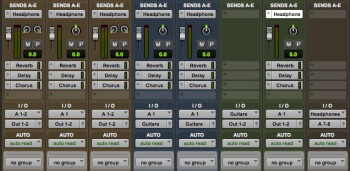To close the chapter dedicated to the use of delay during mixdown, we'll look into the relationship between reverb and delay.
The perfect match
Reverb and delay often develop in parallel within a mix. For example, it’s not unusual for a vocal track to be sent to two different aux buses, one with a reverb to give it depth and the other one with a stereo delay to make the signal thicker. However, these two effects can also be used in series. What for? That’s what we’re about to see, but before we do just that, I’ll address a technical matter.
For this connection in series to work best, you need to observe a fixed order: delay before reverb. You can obviously experiment with the inverse order, but it won’t take you long to realize that it’s probably not that interesting. Using even a simple delay after the reverb will result in the addition of several copies of the diffused sound field to the signal, which will only make the result blurry and drown the processed signal in a fuzzy environment.
So, again, you should place the delay before the reverb. But what good can this be? Several things come to mind, actually. First of all, a basic delay without any feedback can replace the pre-delay setting of a reverb. So what, you ask? Well, not all reverbs have such a parameter, like some Plate and Spring reverbs. Furthermore, as I already explained, the pre-delay can represent two things, depending on the reverb: the time separating the source signal from the overall reverberation, or only the time between the source and the diffused sound field. And, in this second case, it might be interesting to delay the first reflections as well, and that’s where the delay comes in.
Or you could also use the delay to replace the early reflections of your reverb if they don’t quite suit your needs. To do that you need to first remove them from the reverb and play with the feedback as well as the delay’s EQ. But what’s the point, you ask? To simplify the pattern of the early reflections, which can be really complex with some reverbs, while at the same time benefiting from the diffused sound field.
Finally, using the above method but without removing the early reflections you can emphasize the sense of depth of a reverb lacking the perspective effect.
Looking back…
And this is how we come to the end of this chapter dedicated to working space with delay and reverb. And since we are right in the middle of the loop, I remind you that it’s important to review all previous stages to fine tune the mix according to the new situation. Once done, I recommend you to create a new export/import of the song and compare it to the different bounces you’ve done so far so you can realize how things have evolved. It’s been a long way since we began our journey, hasn’t it? With this in mind, and before the next episode, take the time to analyze how your mix has evolved, so you can really grasp the progress you’ve made so far.

